Aerodynamic Characteristics and Its Sensitivity Analysis of a Cylindrical Projectile at Different Incidences
Abstract
1. Introduction
2. Aerodynamic Characteristics Analysis Model of a Cylindrical Projectile
2.1. Physical Model
2.2. CFD Model
2.3. Dynamic Derivative Identification
2.4. Numerical Solution Algorithms
3. Sensitivity Analysis of Aerodynamic Characteristics
4. Numerical Simulation and Analysis
4.1. Aerodynamic Characteristics Analysis
4.2. Results of Sensitivity Analysis
5. Conclusions
- (1)
- For the cylindrical projectile model, the lift-to-drag ratio increases with the increase in the angle of attack from 0° to 30°, and then the lift-to-drag ratio tends to decrease when the angle of attack exceeds 60°; the absolute value of the pitching moment coefficient firstly increases with the increase in the angle of attack, and the static stability of the cylindrical projectile model becomes better after the angle of attack is 60°; with the increase in the angle of attack, the dynamic derivative of the cylindrical projectile model fluctuates in a small range, and the maximum value occurs when the angle of attack is 30°, which means that the dynamic stability of the model is the worst at this time.
- (2)
- The centroid position has the greatest effect on the lift coefficient and drag coefficient, while the incoming velocity has the greatest effect on the pitch moment coefficient and combined dynamic derivatives, when the angle of attack is 10°; at different angles of attack, the effect of the four design parameters on the aerodynamic characteristics varies. In order to ensure the dynamic performance of the different angle of attack maneuvering, the influence of these four parameters should be fully and comprehensively considered in practical design.
Author Contributions
Funding
Institutional Review Board Statement
Informed Consent Statement
Data Availability Statement
Conflicts of Interest
References
- Hankey, W.L.; Graham, J.E.; Shang, J.S. Navier-Stokes solution of a slender body of revolution at incidence. AIAA J. 1982, 20, 776–781. [Google Scholar] [CrossRef]
- Degani, D.; Marcus, S.W. Thin vs full Navier-Stokes computation for high-angle-of-attack aerodynamics. AIAA J. 1996, 35, 565–567. [Google Scholar] [CrossRef]
- Yang, Y.J.; Cui, E.I.; Zhou, W.J. Numerical studies about a symmetric vortex flow around a slender body at high incidence. Chin. J. Theor. Appl. Mech. 2004, 36, 1–8. [Google Scholar]
- Liu, X.M.; Fu, S. Numerical simulation of separated flows over slender body at high-angle-of-attack with k-ε model conforming realizability. Chin. J. Comput. Mech. 2006, 23, 275–279. [Google Scholar]
- Zhang, H.X. Structural Analysis of Separated Flows and Vortex Motion; National Defense Industry Press: Beijing, China, 2005. [Google Scholar]
- Tian, S.L. Research on Overlapping Grid Algorithm Based on Unstructured Grid Method. Doctoral Dissertation, Nanjing University of Aeronautics and Astronautics, Nanjing, China, 2008. [Google Scholar]
- Zhu, Y.; Yuan, H.; Lee, C. Experimental investigations of the initial growth of flow asymmetries over a slender body of revolution at high angles of attack. Phys. Fluids 2015, 27, 084103. [Google Scholar] [CrossRef]
- Qi, Z.; Wang, Y.; Bai, H.; Sha, Y.; Li, Q. Effects of micro perturbations on the asymmetric vortices over a blunt-nose slender body at a high angle of attack. Eur. J. Mech./B Fluids 2018, 68, 211–218. [Google Scholar] [CrossRef]
- Wang, X.; Wang, Z.W.; Ruan, W.J. Analysis on flowfield and aerodynamic characteristics of escort free-flight decoy with asymmetrical tail at high incidences. J. Ordnance Equip. Eng. 2021, 42, 55–60+82. [Google Scholar]
- Ramberg, S.E. The effects of yaw and finite length upon the vortex wakes of stationary and vibrating circular cylinders. J. Fluid Mech. 1983, 128, 81–107. [Google Scholar] [CrossRef]
- Zdravkovich, M.M. Flow around Circular Cylinders: Volume 2: Applications; Oxford University Press: Oxford, UK, 1997. [Google Scholar]
- Silva-Leon, J.; Cioncolini, A. Effect of inclination on vortex shedding frequency behind a bent cylinder: An experimental study. Fluids 2019, 4, 100. [Google Scholar] [CrossRef]
- Alam, M.M.; Abdelhamid, T.; Sohankar, A. Effect of cylinder corner radius and attack angle on heat transfer and flow topology. Int. J. Mech. Sci. 2020, 175, 105566. [Google Scholar] [CrossRef]
- Hoang, N.T.; Rediniotis, O.K.; Telionis, D.P. Symmetric and asymmetric separation patterns over a hemisphere cylinder at low reynolds numbers and high incidences. J. Fluids Struct. 1997, 11, 793–817. [Google Scholar] [CrossRef]
- Nabi, S.; Ahanger, M.A.; Dar, A.Q. Investigating the potential of Morris algorithm for improving the computational constraints of global sensitivity analysis. Environ. Sci. Pollut. Res. 2021, 28, 60900–60912. [Google Scholar] [CrossRef] [PubMed]
- Yu, Y.R.; Li, C.; Yao, L.Q. Global sensitivity analysis on vertical model of railway vehicle based on extended Fourier amplitude sensitivity test. J. Vib. Shock. 2014, 33, 77–81. [Google Scholar]
- Sobol, I.M. Sensitivity estimates for nonlinear mathematical models. Math. Model. Comput. Exp. 1993, 1, 112–118. [Google Scholar]
- Antoniadis, A.; Lambert-Lacroix, S.; Poggi, J.M. Random forests for global sensitivity analysis: A selective review. Reliab. Eng. Syst. Saf. 2021, 206, 107312. [Google Scholar] [CrossRef]
- Du, W.Q.; Li, S.X.; Luo, Y.X. Implementation of Sobol’s sensitivity analysis to cyclic plasticity model with parameter uncertainty. Int. J. Fatigue 2021, 155, 106578. [Google Scholar] [CrossRef]
- Liu, Q.; Feng, B.W.; Liu, Z.Y.; Hao, Z.; Zhang, H. The improvement of Sobol’ sensitivity analysis method. In Proceedings of the 2015 First International Conference on Reliability Systems Engineering (ICRSE), Beijing, China, 21–23 October 2015. [Google Scholar]
- Tao, L.; Xie, Y.; Hu, C. Efficient sensitivity analysis for enhanced heat transfer performance of heat sink with swirl flow structure under one-side heating. Energies 2022, 15, 7342. [Google Scholar] [CrossRef]
- Boussinesq, J. Essay on the Theory of Water Currents. In Memoirs Presented by Various Scholars to the Academy of Sciences; Series 2; Institute of France: Paris, France, 1877; Volume 23, pp. 46–50. [Google Scholar]
- Menter, F.R. Two-equation eddy-viscosity turbulence models for engineering applications. AIAA J. 1994, 32, 1598–1605. [Google Scholar] [CrossRef]
- Allen, J.; Ghoreyshi, M. Forced motions design for aerodynamic identification and modeling of a generic missile configuration. Aerosp. Sci. Technol. 2018, 77, 742–754. [Google Scholar] [CrossRef]
- Liu, J.; Xu, C.G.; Bai, X.Z. Finite Volume Method and Unstructured Moving Grids; Science Press: Beijing, China, 2016. [Google Scholar]
- Krishnamurthy, T. Response surface approximation with augmented and compactly supported radial basis functions. In Proceedings of the 44th AIAA/ASME/ASCE/AHS/ASC Structures, Structural Dynamics, and Materials Conference, Norfolk, VA, USA, 7–10 April 2003. [Google Scholar]
- Ye, P.C. Research on Surrogate Modeling Techniques and Applied to Shape Design of Autonomous Underwater Glider. Doctoral Dissertation, Northwestern Polytechnical University, Xi’an, China, 2017. [Google Scholar]


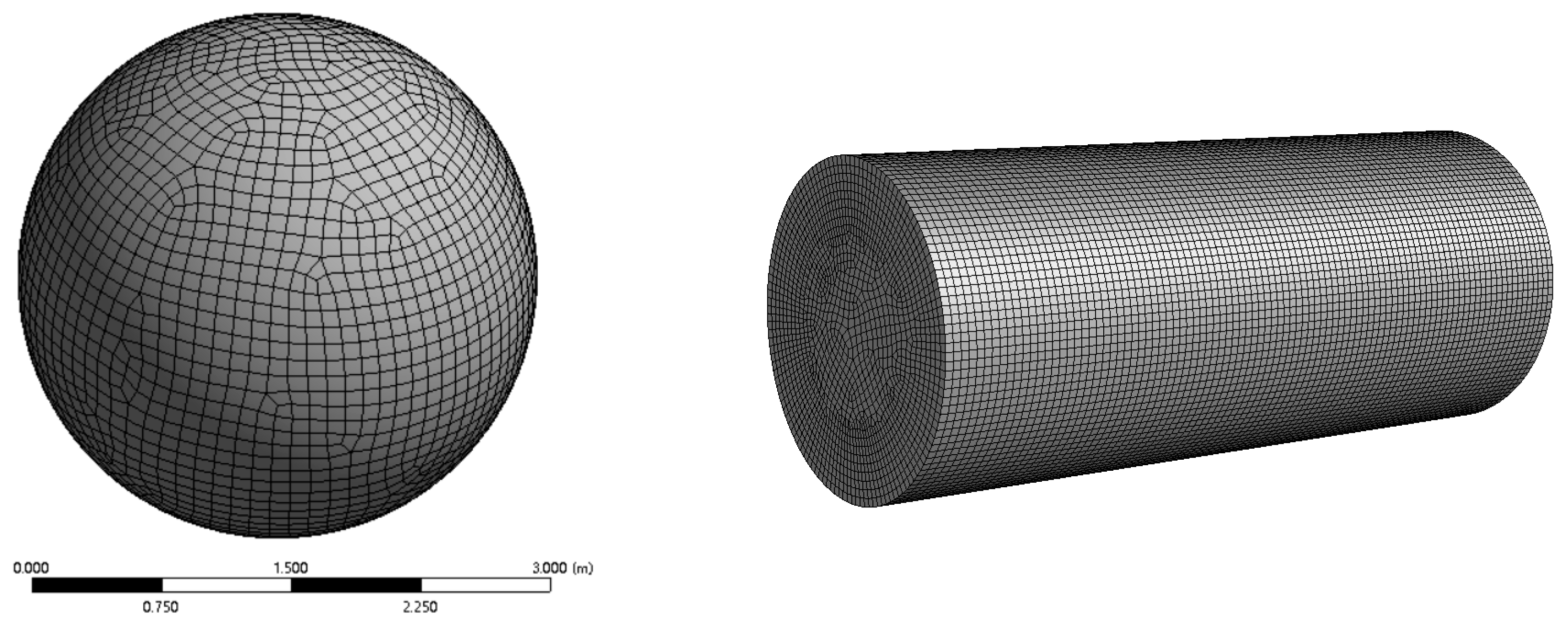
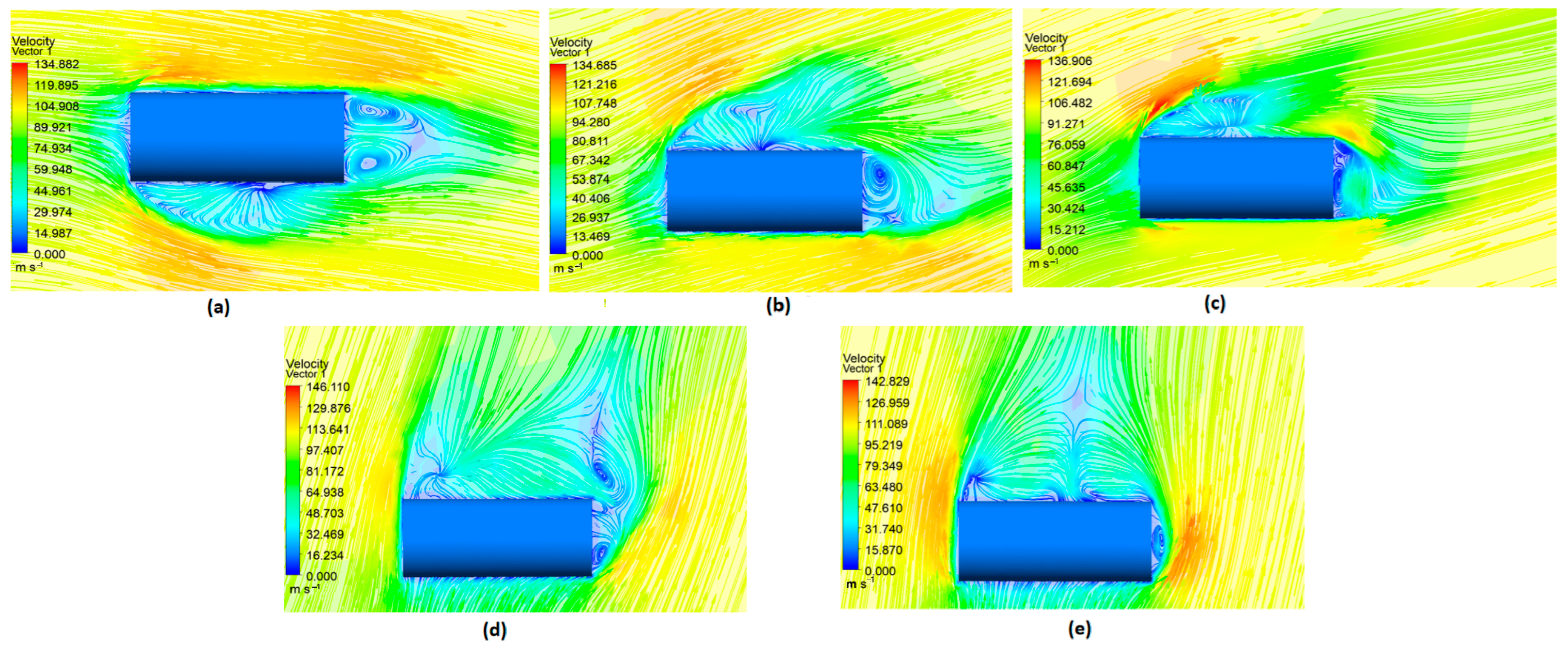
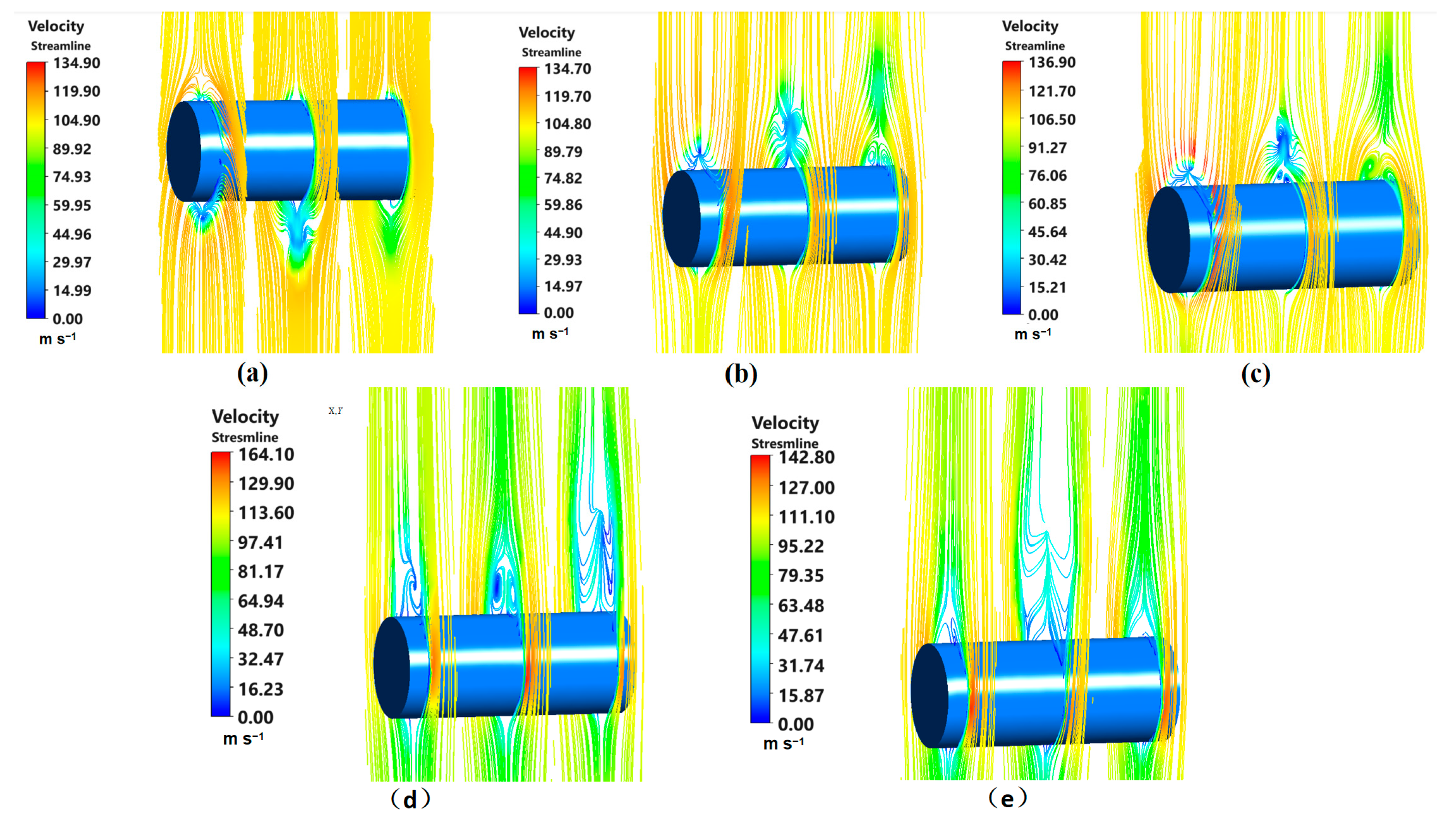
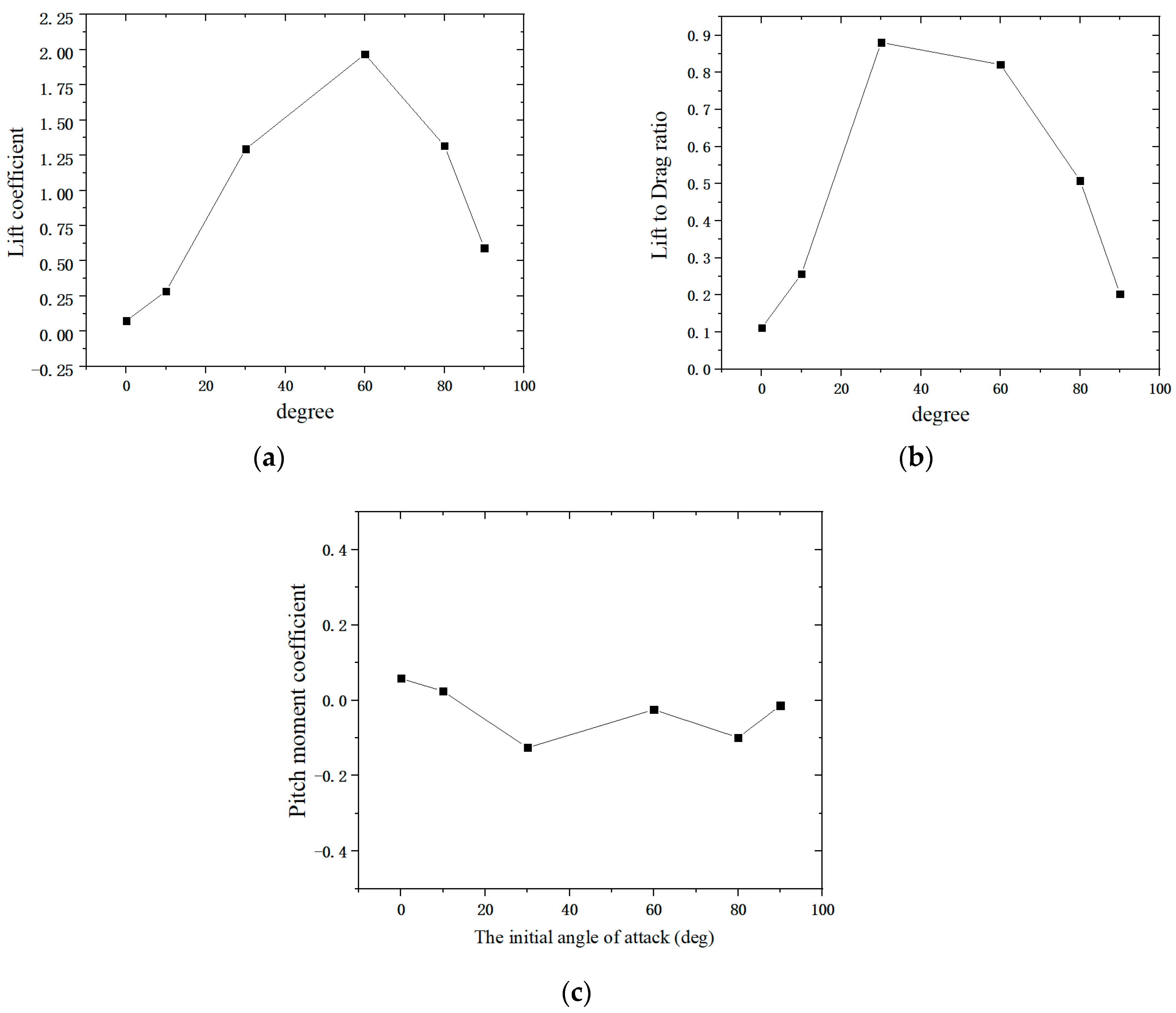
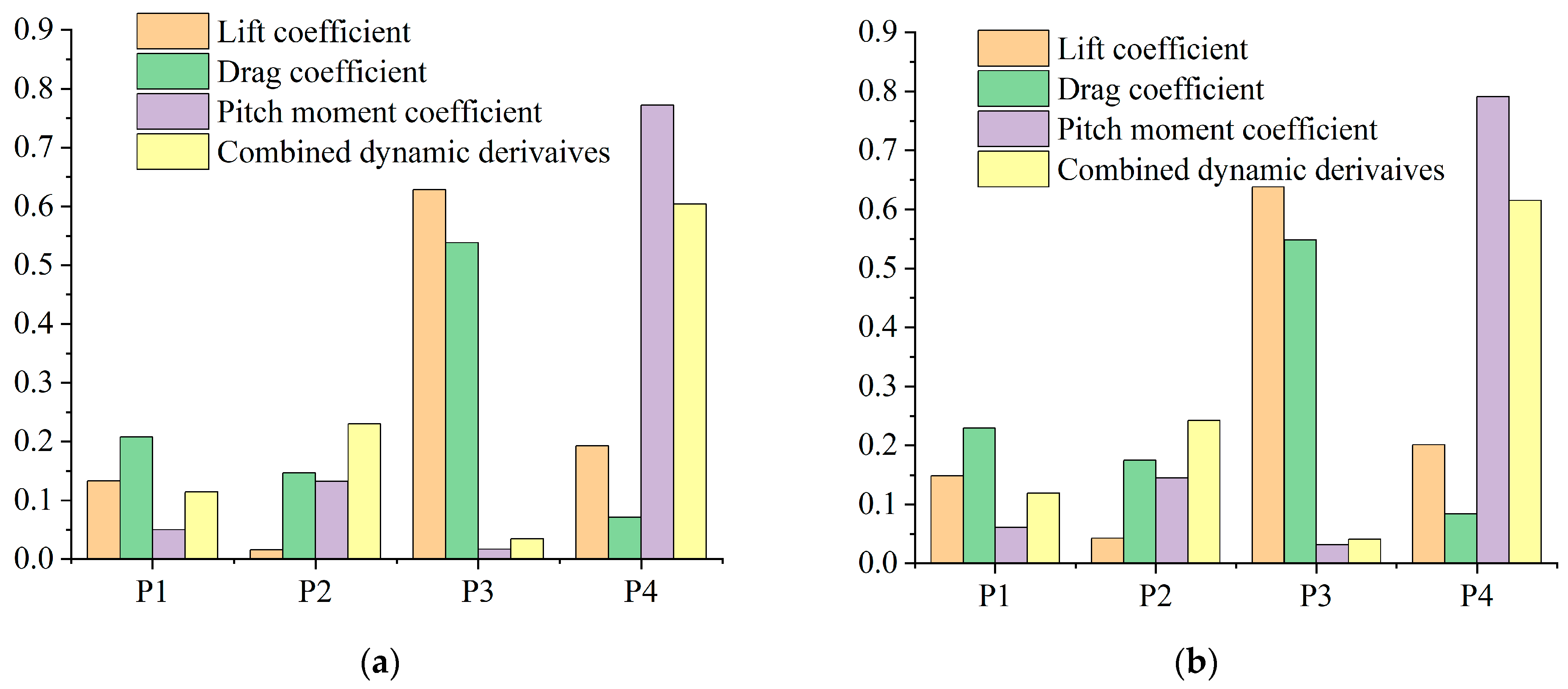

| Parameter | Mach (Ma) | Pressure (Pa) | Temperature (K) | Reduction Frequency | Amplitude /deg | Roll Angle /deg |
|---|---|---|---|---|---|---|
| Value | 0.3 | 100 | 288 | 3 | 1 | 90 |
| Grid Number | Number of Grids | Number of Nodes | Lift Coefficient | Drag Coefficient |
|---|---|---|---|---|
| 1 | 87,394 | 26,164 | 1.0999 | 1.3036 |
| 2 | 93,118 | 27,175 | 1.0491 | 1.2873 |
| 3 | 117,365 | 31,539 | 1.0288 | 1.2734 |
| Initial Angles of Attack | 0° | 10° | 30° | 60° | 80° | 90° |
|---|---|---|---|---|---|---|
| Value | −0.047 | −0.057 | −0.031 | −0.046 | −0.049 | −0.057 |
| Serial Number | Parameters | Value Range |
|---|---|---|
| P1 | Radius (m) | 0.05–0.2 |
| P2 | Length (m) | 0.48–0.68 |
| P3 | Centroid position (m) | 0.1–0.45 |
| P4 | Inlet flow field velocity (Ma) | 0.1–0.5 |
| Parameters | P1/Radius | P2/Length | P3/Centroid Position | P4/Inlet Flow Field Velocity | |
|---|---|---|---|---|---|
| First-Order Sensitivity | Lift coefficient | 0.133 | 0.016 | 0.628 | 0.193 |
| Drag coefficient | 0.208 | 0.147 | 0.538 | 0.071 | |
| Pitch moment coefficient | 0.050 | 0.132 | 0.017 | 0.772 | |
| Combined dynamic derivatives | 0.114 | 0.230 | 0.037 | 0.604 | |
| Total Sensitivity | Lift coefficient | 0.148 | 0.043 | 0.638 | 0.201 |
| Drag coefficient | 0.229 | 0.175 | 0.549 | 0.084 | |
| Pitch moment coefficient | 0.061 | 0.145 | 0.032 | 0.791 | |
| Combined dynamic derivatives | 0.119 | 0.242 | 0.041 | 0.615 |
Disclaimer/Publisher’s Note: The statements, opinions and data contained in all publications are solely those of the individual author(s) and contributor(s) and not of MDPI and/or the editor(s). MDPI and/or the editor(s) disclaim responsibility for any injury to people or property resulting from any ideas, methods, instructions or products referred to in the content. |
© 2024 by the authors. Licensee MDPI, Basel, Switzerland. This article is an open access article distributed under the terms and conditions of the Creative Commons Attribution (CC BY) license (https://creativecommons.org/licenses/by/4.0/).
Share and Cite
Jiao, S.; Tao, L.; Wang, H.; Wang, X.; Ruan, W. Aerodynamic Characteristics and Its Sensitivity Analysis of a Cylindrical Projectile at Different Incidences. Appl. Sci. 2024, 14, 6683. https://doi.org/10.3390/app14156683
Jiao S, Tao L, Wang H, Wang X, Ruan W. Aerodynamic Characteristics and Its Sensitivity Analysis of a Cylindrical Projectile at Different Incidences. Applied Sciences. 2024; 14(15):6683. https://doi.org/10.3390/app14156683
Chicago/Turabian StyleJiao, Shenghai, Ling Tao, Hao Wang, Xiao Wang, and Wenjun Ruan. 2024. "Aerodynamic Characteristics and Its Sensitivity Analysis of a Cylindrical Projectile at Different Incidences" Applied Sciences 14, no. 15: 6683. https://doi.org/10.3390/app14156683
APA StyleJiao, S., Tao, L., Wang, H., Wang, X., & Ruan, W. (2024). Aerodynamic Characteristics and Its Sensitivity Analysis of a Cylindrical Projectile at Different Incidences. Applied Sciences, 14(15), 6683. https://doi.org/10.3390/app14156683





